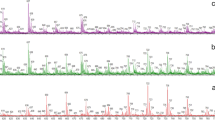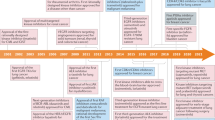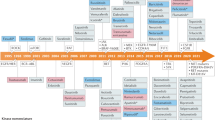Abstract
Protein kinase inhibitors have applications as anticancer therapeutic agents and biological tools in cell signaling. Based on a phosphoryl transfer mechanism involving a dissociative transition state, a potent and selective bisubstrate inhibitor for the insulin receptor tyrosine kinase was synthesized by linking ATPγS to a peptide substrate analog via a two-carbon spacer. The compound was a high affinity competitive inhibitor against both nucleotide and peptide substrates and showed a slow off-rate. A crystal structure of this inhibitor bound to the tyrosine kinase domain of the insulin receptor confirmed the key design features inspired by a dissociative transition state, and revealed that the linker takes part in the octahedral coordination of an active site Mg2+. These studies suggest a general strategy for the development of selective protein kinase inhibitors.
This is a preview of subscription content, access via your institution
Access options
Subscribe to this journal
Receive 12 print issues and online access
$189.00 per year
only $15.75 per issue
Buy this article
- Purchase on Springer Link
- Instant access to full article PDF
Prices may be subject to local taxes which are calculated during checkout



Similar content being viewed by others
Accession codes
References
Hunter, T. Cell 100, 113–127 ( 2000).
Showalter, H.D. & Kraker, A.J. Pharmacol. Ther. 76, 55–71 ( 1997).
Lawrence, D.S. & Niu, J. Pharmacol. Ther. 77, 81–114 (1998).
G. Rosse, G. et al. Helvetica Chimica Acta 80, 653– 670 (1997).
Yuan, C.J., Jakes, S., Elliott, S. & Graves, D. J. Biol. Chem. 265, 16205–16209 ( 1990).
Ablooglu, A.J. et al. J. Biol. Chem. 275, 30394– 30398 (2000).
Cushman, M. et al. Int. J. Pept. Protein Res. 36, 538– 543 (1990).
Medzihradszky, D., Chen., S.L., Kenyon, G.L. & Gibson, B.W. J. Am. Chem. Soc. 116, 9413–9419 (1994).
Silverman, R.B. The organic chemistry of drug design and drug action (Academic Press, New York; 1992).
Ho, M., Bramson, H.N., Hansen, D.E., Knowles, J.R. & Kaiser, E.T. J. Am. Chem. Soc. 110, 2680–2681 ( 1988).
Uri, A., Raidaru, G., Jarv, J. & Pia, E. Bioorg. Med. Chem. Lett. 9, 1447–1452 ( 1999).
Kim, K. & Cole, P.A. J. Am. Chem. Soc. 120 , 6851–6858 (1998).
Admiraal, S.J. & Herschlag, D. J. Am. Chem. Soc. 122, 2145–2148 ( 2000).
Mildvan, A.S. Proteins 29, 401–416 ( 1997).
Hubbard, S.R. EMBO J. 16, 5572–5581 ( 1997).
Brown, N.R., Noble, M.E.M., Endicott, J.A. & Johnson, L.N. Nature Cell Biol. 1, 438–443 (1999).
Morrison, J.F. & Walsh, C.T. Adv. Enzymol. 61, 201–301 ( 1988).
Grace, M.R., Walsh, C.T. & Cole, P.A. Biochemistry 36, 1874– 1881 (1997).
Sondhi, D., Xu, W., Songyang, Z., Eck, M.J. & Cole, P.A. Biochemistry 37, 165– 172 (1998).
Taylor, S.S. & Radzio-Andzelm, E. Structure 2, 345–355 (1994).
Knighton, D.R. et al. Science 253 414–420 (1991).
Songyang, Z. et al., Nature 373, 536–539 (1995).
Till, J.H., Annan, R.S., Carr, S.A. & Miller, W.T. J. Biol. Chem. 269, 7423–7428 ( 1994).
Otwinowski, Z. & Minor, W. Methods Enzymol. 276, 307–326 ( 1997).
Brünger, A. et al. Acta Crystallogr. D 54, 905– 921 (1998).
Jones, T.A. Methods Enzymol. 115, 157–171 (1985).
Shoelson, S.E., Chatterjee, S., Chandhuri, M. & White, M.F. Proc. Natl. Acad. Sci. USA 89, 2027– 2031 (1992).
Nicholls, A., Sharp, K.A. & Honig, B. Proteins 11, 281– 296 (1991).
Esnouf, R.M. J. Mol. Graph. 15, 132–134 (1997).
Kraulis, P.J. J. Appl. Crystallogr. 24, 946–950 (1991).
Acknowledgements
We gratefully acknowledge support from the NIH (to R.A.K., S.R.H. and P.A.C.), and the Burroughs Wellcome Fund. We thank A. Mildvan for helpful discussions and critical reading of the manuscript. X-ray equipment at The Skirball Institute is partially supported by grants from The Kresge Foundation and The Hyde and Watson Foundation.
Author information
Authors and Affiliations
Corresponding authors
Rights and permissions
About this article
Cite this article
Parang, K., Till, J., Ablooglu, A. et al. Mechanism-based design of a protein kinase inhibitor. Nat Struct Mol Biol 8, 37–41 (2001). https://doi.org/10.1038/83028
Received:
Accepted:
Issue Date:
DOI: https://doi.org/10.1038/83028
This article is cited by
-
Rational drug-design approach supported with thermodynamic studies — a peptide leader for the efficient bi-substrate inhibitor of protein kinase CK2
Scientific Reports (2019)
-
Design of substrate-based BCR-ABL kinase inhibitors using the cyclotide scaffold
Scientific Reports (2015)
-
Enhanced interrogation: emerging strategies for cell signaling inhibition
Nature Structural & Molecular Biology (2010)
-
Chemical probes for histone-modifying enzymes
Nature Chemical Biology (2008)



